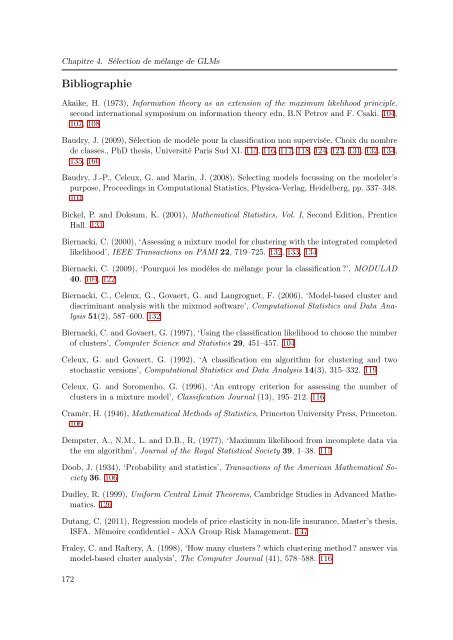Mélanges de GLMs et nombre de composantes : application ... - Scor
Mélanges de GLMs et nombre de composantes : application ... - Scor
Mélanges de GLMs et nombre de composantes : application ... - Scor
Create successful ePaper yourself
Turn your PDF publications into a flip-book with our unique Google optimized e-Paper software.
Chapitre 4. Sélection <strong>de</strong> mélange <strong>de</strong> <strong>GLMs</strong><br />
Bibliographie<br />
Akaike, H. (1973), Information theory as an extension of the maximum likelihood principle,<br />
second international symposium on information theory edn, B.N P<strong>et</strong>rov and F. Csaki. 104,<br />
107, 108<br />
Baudry, J. (2009), Sélection <strong>de</strong> modèle pour la classification non supervisée. Choix du <strong>nombre</strong><br />
<strong>de</strong> classes., PhD thesis, Université Paris Sud XI. 115, 116, 117, 118, 124, 127, 131, 132, 134,<br />
135, 160<br />
Baudry, J.-P., Celeux, G. and Marin, J. (2008), Selecting mo<strong>de</strong>ls focussing on the mo<strong>de</strong>ler’s<br />
purpose, Proceedings in Computational Statistics, Physica-Verlag, Hei<strong>de</strong>lberg, pp. 337–348.<br />
104<br />
Bickel, P. and Doksum, K. (2001), Mathematical Statistics, Vol. I, Second Edition, Prentice<br />
Hall. 131<br />
Biernacki, C. (2000), ‘Assessing a mixture mo<strong>de</strong>l for clustering with the integrated compl<strong>et</strong>ed<br />
likelihood’, IEEE Transactions on PAMI 22, 719–725. 132, 133, 134<br />
Biernacki, C. (2009), ‘Pourquoi les modèles <strong>de</strong> mélange pour la classification ?’, MODULAD<br />
40. 104, 122<br />
Biernacki, C., Celeux, G., Govaert, G. and Langrogn<strong>et</strong>, F. (2006), ‘Mo<strong>de</strong>l-based cluster and<br />
discriminant analysis with the mixmod software’, Computational Statistics and Data Analysis<br />
51(2), 587–600. 132<br />
Biernacki, C. and Govaert, G. (1997), ‘Using the classification likelihood to choose the number<br />
of clusters’, Computer Science and Statistics 29, 451–457. 104<br />
Celeux, G. and Govaert, G. (1992), ‘A classification em algorithm for clustering and two<br />
stochastic versions’, Computational Statistics and Data Analysis 14(3), 315–332. 119<br />
Celeux, G. and Soromenho, G. (1996), ‘An entropy criterion for assessing the number of<br />
clusters in a mixture mo<strong>de</strong>l’, Classification Journal (13), 195–212. 116<br />
Cramér, H. (1946), Mathematical M<strong>et</strong>hods of Statistics, Princ<strong>et</strong>on University Press, Princ<strong>et</strong>on.<br />
106<br />
Dempster, A., N.M., L. and D.B., R. (1977), ‘Maximum likelihood from incompl<strong>et</strong>e data via<br />
the em algorithm’, Journal of the Royal Statistical Soci<strong>et</strong>y 39, 1–38. 115<br />
Doob, J. (1934), ‘Probability and statistics’, Transactions of the American Mathematical Soci<strong>et</strong>y<br />
36. 106<br />
Dudley, R. (1999), Uniform Central Limit Theorems, Cambridge Studies in Advanced Mathematics.<br />
126<br />
Dutang, C. (2011), Regression mo<strong>de</strong>ls of price elasticity in non-life insurance, Master’s thesis,<br />
ISFA. Mémoire confi<strong>de</strong>ntiel - AXA Group Risk Management. 147<br />
Fraley, C. and Raftery, A. (1998), ‘How many clusters ? which clustering m<strong>et</strong>hod ? answer via<br />
mo<strong>de</strong>l-based cluster analysis’, The Computer Journal (41), 578–588. 116<br />
172
















